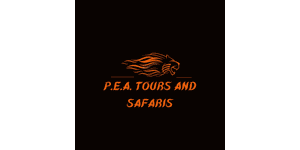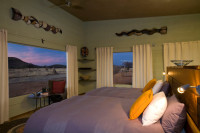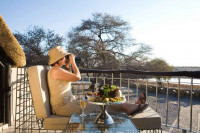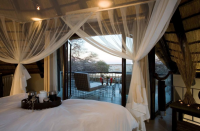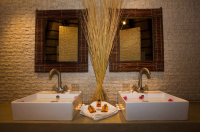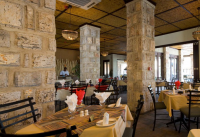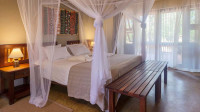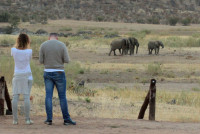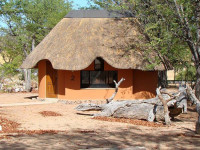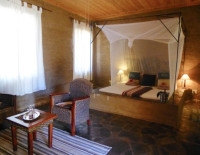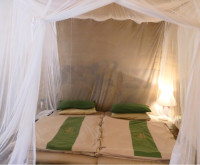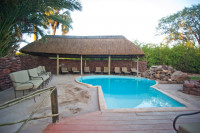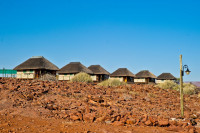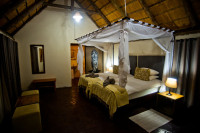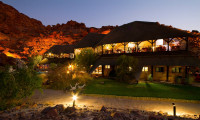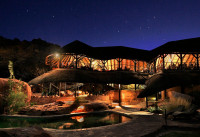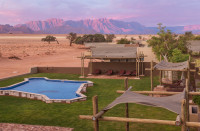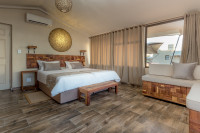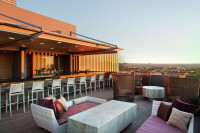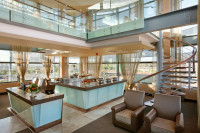
Arrival
Arrival

Day 1
Okonjima Private Game Reserve (Home of the AfriCat Foundation)
Okonjima Private Game Reserve (Home of the AfriCat Foundation)
After meeting your Specialist Guide, you will drive to Okonjima Nature Reserve, which is the home to the AfriCat Foundation. Founded in 1993, the AfriCat Foundation is primarily dedicated to conservation of large carnivores. The Foundation lies on a 22000-hectare Okonjima Private Game Reserve. This afternoon you will visit the center and learn more about Namibia’s carnivores and their fight for survival and the Human-Wildlife Conflict challenges that face both man and carnivore. Both Okonjima and AfriCat are dedicated to creating conservation awareness through environmental education at all ages and levels, rehabilitation and reintroduction programs, and conducts constructive wildlife research. We get a chance to see their ambassador Cheetahs during this tour.
- Main Destination:
- Okonjima Private Nature Reserve
- Accommodation:
- Okonjima Plains Camp
- Meals & Drinks:

Day 2
Okonjima Private Game Reserve (Home of the AfriCat Foundation)
Okonjima Private Game Reserve (Home of the AfriCat Foundation)
We will go for White Rhino tracking on foot. There is a small population of Rhinos that are constantly monitored by the anti-poaching team. The activity is more of a game drive first with high chances of encountering one of the collared leopards that are wild and free roaming. In the afternoon, we will go for Pangolin tracking. The reserve has a healthy population of this elusive and endangered mammal, and they are conducting research, therefore they have some that can be tracked using VHF radio telemetry. Pangolins are the most trafficked mammal worldwide, hence threatening their future survival. All 8 species of pangolin worldwide are listed on the red list of threatened species and prohibited from international commercial trade under the Convention on International Trade in Endangered Species of Wild Fauna and Flora (Cites). All though our primary focus will be pangolin, we are still conducting a game drive and chances of seeing other mammals and special birds along the way.
- Main Destination:
- Okonjima Private Nature Reserve
- Accommodation:
- Okonjima Plains Camp
- Meals & Drinks:

Day 3
Etosha National Park South
Etosha National Park South
After breakfast we will head towards Etosha, past the Cheetah Conservation Fund. It was established in 1990 to develop a permanent conservation research center for Cheetah. The aim of the organization is to secure habitats for the long-term survival of cheetah and their ecosystem through multi-disciplined and integrated programs of conservation, research and education. Besides seeing their ambassador cheetahs, we will learn more on historic distribution of the Cheetah and how their range and numbers have diminished. We learn how they breed the Anatolian shepherd and Kangal dogs to become livestock guard dogs. Now, and for thousands of years, the breed is used to guard small livestock against wolves and bears in Turkey. These are placed with Namibian farmers as puppies. The puppies' bond with the herd or flock. As they grow up, their size and loud bark help to scare predators away. After lunch we will make our way to Etosha and do the afternoon game drive in the Etosha National Park.
- Main Destination:
- Etosha National Park
- Accommodation:
- Okaukuejo Resort
- Meals & Drinks:

Day 4
Etosha National Park South
Etosha National Park South
We have a full day in the Etosha National Park, with a lunch/siesta break in between. It is a 22 270 km2 park with 114 mammal species and over 350 bird species. Etosha means “Great White Place” in local Oshindonga language, referring to the 4800 km2 salt pan that covers 23% of the park’s surface area. Mammals include Black and White Rhinoceros, Lion, Leopard, Cheetah, African elephant, Plains and Hartmann’s Mountain Zebras, Southern Giraffe subs angolensis, Eland, Gemsbok, African Wild Cat, Spotted and Brown Hyeana among other animals. It was declared a game reserve in 1907. The area was approximately 100 000 km2 covering the current park and most of Kaokoland- between the Kunene and Hoarusib rivers. The aim was to stem the rapid depletion of the animals in the area and protect all of the land through which seasonal migrations passed. It was reduced to 60 000 km2 in 1958 and to the current size in 1970.
- Main Destination:
- Etosha National Park
- Accommodation:
- Okaukuejo Resort
- Meals & Drinks:
Day 5
Hobatere Concession
Hobatere Concession
We have another full day in the Etosha, driving from the southern part to the less visited western Etosha. Hobatere is outside the park on the western side and belongs to #Khoadi//Hoas Conservancy. The primary objective is to increase the benefits to the local community, reducing human-wildlife conflict and also conservation of the area. Covering an area of 8 808 hectares, this concession is a conservation success story because the of creation of Trust Fund for Traditional Authorities financially benefits the conservancy and contributes to reducing human-wildlife conflict. The fund also provides tuition fees for students from families who cannot afford them. The lodge supports the community with projects such as building clinics, schools, water points and a community kitchen for the elderly and vulnerable people.
After dinner we will go for a night drive, with luck we might encounter nocturnal animals like Aardvark, Cape Fox, Bat-eared Fox, Aardwolf, Small Spotted Genet.
- Main Destination:
- Western Etosha National Park
- Accommodation:
- Hobatere Lodge
- Meals & Drinks:
Day 6
Hobatere Concession
Hobatere Concession
We will do both morning and afternoon game drives around the concession with local guides. We will learn more about the plant and bird life, admire the amazing termite mound structures among big mopane trees. If we are lucky, we might even spot a herd of elephants or local pride of lions, while birding enthusiasts will appreciate the large variety of species. AfriCat North, primarily the AfriCat Foundation field-base for lion research, human-wildlife conflict mitigation and community support. They operate around Hobatere concession and other areas western Etosha. The Namibian Lion Trust conducts research and monitoring of Lions outside Etosha where coexist with cattle farming communities. Their conservation programs including employment of local Lion Guards, Gps collaring and Predator Proof pens to mitigate lion-farmer conflict.
- Main Destination:
- Western Etosha National Park
- Accommodation:
- Hobatere Lodge
- Meals & Drinks:
Day 7
Hoanib River
Hoanib River
After breakfast, we will drive towards the desert into one of the most important conservation ephemeral rivers in Namibia, the Hoanib River. Being 270 km in length, the Hoanib River goes all the way to the sea and borders northern Damaraland and Kaokoland. There are thriving populations of desert Adapted Elephants, Oryx, Steenbok, Springbok, Black-backed Jackals, Small spotted Genets, Southern Giraffe subs angolensis among others.
We will explore the wildlife in the Hoanib River in the late afternoon sundowner drive.
- Main Destination:
- Sesfontein (Town)
- Accommodation:
- Fort Sesfontein Lodge
- Meals & Drinks:
Day 8
Hoanib River
Hoanib River
We will do a full day game drive in search of desert-adapted wildlife. As far as conservation is concerned, we will learn more about Desert Adapted Lion Conservation. With approximately 120 of their kind left, Desert Adapted Lions are a rare group of carnivores that have adapted to survive in one of the harshest, most unforgiving landscapes on earth. With numbers dwindling as human encroachment threaten their future, sightings are few and far between. However, with luck, one might see them. They are asset to Namibia, and we need to conserve and manage them wisely for the benefit of the Namibian people, as well as the broader international community. The Desert Lion Conservation in a renowned organization that collaborates with Government, local communities and the tourism industry to further lion conservation and address human-lion conflict. They basically collect baseline ecological data on the population dynamics, behaviour, and movements of lions.
- Main Destination:
- Sesfontein (Town)
- Accommodation:
- Fort Sesfontein Lodge
- Meals & Drinks:

Day 9
Palmwag/Grootberg Area
Palmwag/Grootberg Area
We will drive after breakfast to Palmwag Concession. It covers 4500km2 wilderness area not bordered by any fence. After lunch we will relax before embarking on a sundowner drive in our own vehicle in the afternoon. There is a possibility of seeing the Desert Adapted Elephants among other wildlife around this area.
- Main Destination:
- Palmwag (Damaraland)
- Accommodation:
- Palmwag Lodge
- Meals & Drinks:

Day 10
Palmwag/Grootberg Area
Palmwag/Grootberg Area
An early morning starts with a packed breakfast; we will head out in search of Desert Adapted Black Rhino. We will be taken by local guides and Rhino Rangers. The Namib Desert is home to the last truly wild stronghold of black rhino. This activity involves 4 x 4 driving in a rugged terrain and walking safari to get to the rhinos if lucky. These mammals are not in a fenced area but in an open ecosystem. It is a joint venture of the Namibian Ministry of Environment and Tourism, the communities, Save Rhino Trust and other Non-Governmental Organizations in conservation of Black Rhinos. The program of Community-based Natural Resource Management seeks to empower people living in rural areas to manage and benefit from their natural resources.
This activity might take the whole day, however there is still a possibility of a late afternoon sundowner drive in our own vehicle.
- Main Destination:
- Palmwag (Damaraland)
- Accommodation:
- Palmwag Lodge
- Meals & Drinks:

Day 11
Damaraland
Damaraland
We will head towards Twyfelfontein after breakfast, exploring the Huab and Aba-Huab Riverbeds in search for Desert Adapted Elephants. We will learn more about an organization: Elephant-Human Relations Aid whose mission is to implement practical solutions that help combat elephant-human conflict, and thereby secure a future for Namibia’s desert elephants. One of their approaches is building protective walls around water points, educating locals on conflict mitigation tactics and continuous monitoring of the different elephant herds. In this desert, Elephants, livestock and humans share water points of which water is very scarce. This results in conflicts. In the afternoon, we will visit the Bushman Rock Engravings around Twyfelfontein. This area was declared a UNESCO World Heritage Site in 2007 and consists of over 40 000 rock engravings done by the San people 2000 years ago. This is a 45-minute walk and conducted by local guides.
- Main Destination:
- Twyfelfontein (Rock Art)
- Accommodation:
- Twyfelfontein Country Lodge
- Meals & Drinks:

Day 12
Skeleton Coast and Swakopmund
Skeleton Coast and Swakopmund
After breakfast we will head to the coast through the Skeleton Coast National Park. The Namibian Skeleton Coast National Park is renowned for its cold and unpredictable Benguela Current of the Atlantic Ocean that contends with the dune and desert landscape. Wildlife here includes Oryx, Springbok, Black-backed Jackal, Ostrich, Brown Hyaena, Desert Adapted Elephant, Black Rhino and Lion. Because of the harshness of the area, these animals do not occur in huge numbers and not very easily spotted, so let’s keep our eyes peeled. After lunch we will make our way to the Cape Cross Seal Reserve. This is 60km2 Reserve and has the largest Seal Colony in the world, with numbers up to 240 000 at a given time. There is a lot of controversy in terms of conservation of Cape Fur Seals versus harvesting them.
- Main Destination:
- Swakopmund (City)
- Accommodation:
- The Delight Swakopmund
- Meals & Drinks:

Day 13
Skeleton Coast and Swakopmund
Skeleton Coast and Swakopmund
We will embark on the Living Desert Tour activity in the Dorob National Park. Dry bone, without a trace of moisture and as dry as a weathered bone! These terms may be used to describe this unique biome with sneaky creatures that have adapted to living in harsh environment. For these little creatures either camouflage or agility to faking deaths, helps in serving food on the table or avoid being someone’s meal somehow.
This is a 4 to 5-hour tour conducted by passionate and experienced desert specialists who are desert conservationists as well. If lucky you might see the desert “Little Five”; Shovel-nosed Lizard, Namib Sand Gecko, Namaqua Chameleon, Namib Desert Sidewinding Adder and the Cartwheeling Spider (“Dancing White Lady”). Birds of interest include Gray’s Lark, Tractrac Chat, Damara Tern among others. You a should be back around lunch time and enjoy a stroll around the Swakopmund city or take any optional activities that we can arrange for you in advance.
- Main Destination:
- Swakopmund (City)
- Accommodation:
- The Delight Swakopmund
- Meals & Drinks:

Day 14
The Namib Desert
The Namib Desert
We will drive towards Sossusvlei in the morning after breakfast. This scenic drive gives us a chance to explore the Namib Desert which is unoccupied by humans. Wildlife is rather very scattered and undisturbed.
This afternoon we will embark on a Sundowner Drive around the Private Game Reserve.
- Main Destination:
- Sossusvlei (Sand Dunes)
- Accommodation:
- Sossusvlei Lodge
- Meals & Drinks:

Day 15
Windhoek
Windhoek
An early morning start will see us getting into the Namib Naukluft Park. The Namib Naukluft Park is the third largest National Park in Africa covering and area of 50 000 km2. The Namib desert has been arid for about 80 million years, with true desert conditions predominating the last 15 to 20 million years. Various wildlife thriving in this area includes Gemsbok, Springbok, Brown Hyaena, Black-backed Jackal among others. If lucky, you might see the only true Namibia Endemic bird, the Dune Lark among various birds in this area. We will visit the most photographed sand dune in the area, Dune 45. Depending on your energy levels, climbing one of the highest sand dunes in the area, the Big Daddy, is quite fun. A visit to the Dead Vlei is worthwhile. This a white clay pan with dry Camel Thorn trees that are believed to have been dead 800 years ago. The area is so dry that the trees have not decomposed.
After lunch, we will for Windhoek. W.
- Main Destination:
- Windhoek (City)
- Accommodation:
- Hilton Hotel Windhoek
- Meals & Drinks:

Day 16
Hosea Kutako International Airport
Hosea Kutako International Airport
This marks the end of our Specialized Conservation Safari. You will transferred to the airport for outbound international flight.
- Main Destination:
- Windhoek Airport (Windhoek)
- Accommodation:
- No accommodation (End of tour)
- Meals & Drinks:

